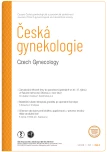Registration of a pregnant woman in the maternity hospital (optimally at 36th–37th weeks) at the Olomouc University Hospital in 2022
Authors:
M. Ľubušký 1; V. Durdová 1; T. Kratochvílová 1; M. Maděrková Tozzi 1; K. Campsie 1; A. Šinská 1; E. Hostinská 1; M. Studničková 1; R. Černohouzová 1; M. Knápek 2; Z. Kabátek 3; M. Jankůj 3; L. Dušek 4; J. Jírová 4; Radovan Pilka 1
Authors‘ workplace:
Porodnicko-gynekologická klinika LF UP a FN Olomouc
1; Ekonomický úsek, FN Olomouc
2; VZP ČR, Praha
3; ÚZIS ČR, Praha
4
Published in:
Ceska Gynekol 2023; 88(4): 242-252
Category:
Original Article
doi:
https://doi.org/10.48095/cccg2023242
Overview
Objective: The aim of the study was to analyse the results of the implementation of the new health service Registration of a pregnant woman in the maternity hospital (optimally at 36th–37th weeks) provided as part of outpatient/ambulatory health care at Olomouc University Hospital (OUH). Materials and methods: A prospective cohort study. In 2022, a total of 2,271 women gave birth in OUH, and 2,010 of them were Registered in the maternity hospital, defined specific risks were identified and a pregnancy termination strategy was established/determined. Results: The health service was provided to 88.5% of women giving birth (2,010/2,271). The age of the mothers was 15–56 years (mean 31.3 years; median 31 years), their body mass index was 13.4–53.1 kg/m2 (mean 24.6 kg/m2; median 23.2 kg/m2). 43.6% of them (877/2,010) were Low-risk pregnancies and 56.4% (1,133/2,010) were Pregnancies with a defined specific risk. The most frequently identified risks were as follows: RhD negative blood group (18.4%), diabetes mellitus (13.9%), history of caesarean section (12.0%), hypertensive disorders (6.5%), small fetus/fetal growth restriction (6.3%), risk the development of hemolytic disease in the fetus and the newborn (2.5%), multiple pregnancy (1.6%), congenital malformation of the fetus (1.3%) and placentation disorders (0.5%). In 63.4% of them (1,275/2,010), the pregnancy termination strategy was determined by spontaneous vaginal delivery, in 18.0% (361/2,010) by pre-induction of vaginal delivery and in 14.2% (285/2,010) by caesarean section. In 4.4% (89/2,010) the health service was not implemented correctly because no strategy was established. Conclusion: The implementation of the new health service will make it possible to replace activity (more frequent antenatal care contacts/visits and routine antenatal cardiotocography) with efficiency (risk identification, determination of the optimal strategy for outpatient/ambulatory antenatal care and timing and mode of delivery) and thereby provide better and safer health care (from a medical, organizational, legislative and economic points of view).
Keywords:
pregnant woman – registration in the maternity hospital – defined specific risks – pregnancy termination strategy – final mode of delivery
Sources
1. FIGO (The International Federation of Gynecology and Obstetrics) consensus guidelines on intrapartum fetal monitoring. Int J Gynaecol Obstet 2015; 131 (1): 3–29.
2. WHO (The World Health Organization) recommendations on antenatal care for a positive pregnancy experience. Online [2016]. Available from: https: //www.who.int/publications/i/ item/9789241549912.
3. Ľubušký M, Kacerovský M, Pařízek A et al. Metodika organizace Komplexní péče o těhotnou ženu v České republice. Gyn Por 2021; 5 (2): 68–75.
4. ČGPS ČLS JEP. Zásady dispenzární péče v těhotenství. Doporučený postup. Sbírka doporučených postupů č. 1/2021.
5. ČR. Předpis č. 48/1997 Sb., Zákon o veřejném zdravotním pojištění a o změně a doplnění některých souvisejících zákonů, Sbírka zákonů České republiky.
6. ČR. Předpis č. 134/1998 Sb., Vyhláška, kterou se vydává seznam zdravotních výkonů s bodovými hodnotami, Sbírka zákonů České republiky.
7. ČR. Předpis č. 372/2011 Sb., Zákon o zdravotních službách a podmínkách jejich poskytování (zákon o zdravotních službách), Sbírka zákonů České republiky.
8. ČR. Předpis č. 373/2011 Sb., Zákon o specifických zdravotních službách, Sbírka zákonů České republiky.
9. ČR. Předpis č. 39/2012 Sb., Vyhláška o dispenzární péči, Sbírka zákonů České republiky.
10. ČR. Předpis č. 98/2012 Sb., Vyhláška o zdravotnické dokumentaci, Sbírka zákonů České republiky.
11. ČR. Předpis č. 116/2012 Sb., Vyhláška o předávání údajů do Národního zdravotnického informačního systému, Sbírka zákonů České republiky.
12. ČR. Předpis č. 373/2016 Sb., Vyhláška o předávání údajů do Národního zdravotnického informačního systému, Sbírka zákonů České republiky.
13. ČR. Předpis č. 254/2019 Sb., Zákon o znalcích, znaleckých kancelářích a znaleckých ústavech, Sbírka zákonů České republiky.
14. ČR. Předpis č. 505/2020 Sb., Vyhláška, kterou se stanoví seznam znaleckých odvětví jednotlivých znaleckých oborů, jiná osvědčení o odborné způsobilosti, osvědčení vydaná profesními komorami a specializační studia pro obory a odvětví, Sbírka zákonů České republiky.
15. ČR. Předpis č. 243/2021 Sb., Vyhláška, kterou se mění vyhláška č. 134/1998 Sb., kterou se vydává seznam zdravotních výkonů s bodovými hodnotami, ve znění pozdějších předpisů, Sbírka zákonů České republiky.
16. ČR. Předpis č. 396/2021 Sb., Vyhláška o stanovení hodnot bodu, výše úhrad hrazených služeb a regulačních omezení pro rok 2022, ve znění pozdějších předpisů, Sbírka zákonů České republiky.
17. NZIS – Národní zdravotnický informační systém. online [2023]. Dostupné z: https: //www.uzis.cz/index.php?pg=nzis.
18. NRRZ – Národní registr reprodukčního zdraví. online [2023]. Dostupné z: https: //www.uzis.cz/index.php?pg=registry-sber-dat—narodni-zdravotni-registry--narodni-registr-reprodukcniho-zdravi.
19. NRRZ-VV – Modul rodiček. online [2023]. Dostupné z: https: //www.uzis.cz/index.php?pg= registry-sber-dat—narodni-zdravotni-registry--narodni-registr-reprodukcniho-zdravi--modul--rodicek.
20. NRRZ-VV – Modul novorozenců. online [2023]. Dostupné z: https: //www.uzis.cz/index.php?pg=registry-sber-dat—narodni-zdravotni-registry--narodni-registr-reprodukcniho-zdravi--modul-novorozencu.
21. Ľubušký M, Dzvinčuk P, Hostinská E et al. Organizace komplexní péče o těhotnou ženu v olomoukém regionu. Gynekolog 2020; 29 (2): 78–81.
Labels
Paediatric gynaecology Gynaecology and obstetrics Reproduction medicineArticle was published in
Czech Gynaecology

2023 Issue 4
Most read in this issue
- The efficacy of human papillomavirus vaccination in the prevention of recurrence of severe cervical lesions
- Therapeutical strategies for recurrent endometrial cancer
- Direct abdominal muscle diastasis and stress urinary incontinence in postpartum women
- Effect of umbilical cord drainage after spontaneous delivery in the third stage of labor
